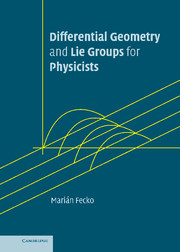Book contents
- Frontmatter
- Contents
- Preface
- Introduction
- 1 The concept of a manifold
- 2 Vector and tensor fields
- 3 Mappings of tensors induced by mappings of manifolds
- 4 Lie derivative
- 5 Exterior algebra
- 6 Differential calculus of forms
- 7 Integral calculus of forms
- 8 Particular cases and applications of Stokes' theorem
- 9 Poincaré lemma and cohomologies
- 10 Lie groups: basic facts
- 11 Differential geometry on Lie groups
- 12 Representations of Lie groups and Lie algebras
- 13 Actions of Lie groups and Lie algebras on manifolds
- 14 Hamiltonian mechanics and symplectic manifolds
- 15 Parallel transport and linear connection on M
- 16 Field theory and the language of forms
- 17 Differential geometry on TM and T *M
- 18 Hamiltonian and Lagrangian equations
- 19 Linear connection and the frame bundle
- 20 Connection on a principal G-bundle
- 21 Gauge theories and connections
- 22 Spinor fields and the Dirac operator
- Appendix A Some relevant algebraic structures
- Appendix B Starring
- Bibliography
- Index of (frequently used) symbols
- Index
17 - Differential geometry on TM and T *M
Published online by Cambridge University Press: 06 July 2010
- Frontmatter
- Contents
- Preface
- Introduction
- 1 The concept of a manifold
- 2 Vector and tensor fields
- 3 Mappings of tensors induced by mappings of manifolds
- 4 Lie derivative
- 5 Exterior algebra
- 6 Differential calculus of forms
- 7 Integral calculus of forms
- 8 Particular cases and applications of Stokes' theorem
- 9 Poincaré lemma and cohomologies
- 10 Lie groups: basic facts
- 11 Differential geometry on Lie groups
- 12 Representations of Lie groups and Lie algebras
- 13 Actions of Lie groups and Lie algebras on manifolds
- 14 Hamiltonian mechanics and symplectic manifolds
- 15 Parallel transport and linear connection on M
- 16 Field theory and the language of forms
- 17 Differential geometry on TM and T *M
- 18 Hamiltonian and Lagrangian equations
- 19 Linear connection and the frame bundle
- 20 Connection on a principal G-bundle
- 21 Gauge theories and connections
- 22 Spinor fields and the Dirac operator
- Appendix A Some relevant algebraic structures
- Appendix B Starring
- Bibliography
- Index of (frequently used) symbols
- Index
Summary
• In this chapter we begin the part of the book in which the concept of the fiber bundle enters the story. Bundles play a significant role in modern geometry and their language as well as techniques are widely used in modern theoretical and mathematical physics. That is why the strategy of ignoring them, although in principle possible, would be fairly short-sighted. In the forthcoming two chapters we will look in some detail at two particular bundles closely associated with Lagrangian and Hamiltonian mechanics, the tangent and cotangent bundle. These (as well as numerous further) bundles may be canonically constructed for an arbitrary manifold M and one can find a fairly rich geometry on them, resulting “free of charge” directly from the way they are defined. Moreover, this additional geometrical structure turns out to be just what is needed for the formulation of the two versions (Lagrangian and Hamiltonian) of classical mechanics. Later on (in Chapter 19) another bundle will be introduced, which may be canonically assigned to an arbitrary manifold M, the frame bundle. It provides a novel view of a linear connection on M. Generalizing the three bundles we will then introduce the concepts of the principal G-bundle and the associated bundle, which turn out to be the essential ingredients needed for the development of the theory of connections and gauge fields.
From a didactic point of view it is convenient to begin to study some particular bundle and to notice its relevant features, which then enter the official abstract definition of the concept of a bundle. The two particular bundles which suit our purpose well are the tangent and cotangent bundles.
- Type
- Chapter
- Information
- Differential Geometry and Lie Groups for Physicists , pp. 478 - 498Publisher: Cambridge University PressPrint publication year: 2006

